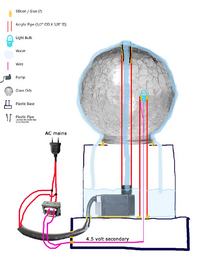vlor
Junior Member level 2
If you can't see the entire image below, right click it and then click View Image.
**broken link removed**
I am making a lamp with water coming down the sides of the glass casing that is around the light bulb, and basically there are two electrical devices that need to be powered up, 1) a pump, and 2) a light bulb.
The light bulb takes 4.5 volts so I had to use this to power it **broken link removed**
The Pump however, looks like it takes 120V. Is there any sort of way to combine these two devices so I can just plug it into the wall using one plug and not two? As you see in the diagram, two cords are sticking out of the base, but I would like to only have a port instead. That way, if the cord gets pulled in any way, it won't mess up the electronics inside. Can anyone help me out? I am a beginner in electronics.
Thanks in advance!
Evan
**broken link removed**
I am making a lamp with water coming down the sides of the glass casing that is around the light bulb, and basically there are two electrical devices that need to be powered up, 1) a pump, and 2) a light bulb.
The light bulb takes 4.5 volts so I had to use this to power it **broken link removed**
The Pump however, looks like it takes 120V. Is there any sort of way to combine these two devices so I can just plug it into the wall using one plug and not two? As you see in the diagram, two cords are sticking out of the base, but I would like to only have a port instead. That way, if the cord gets pulled in any way, it won't mess up the electronics inside. Can anyone help me out? I am a beginner in electronics.
Thanks in advance!
Evan
